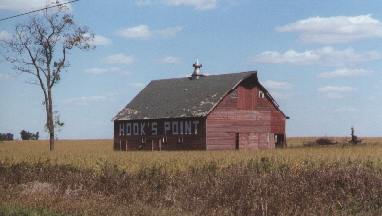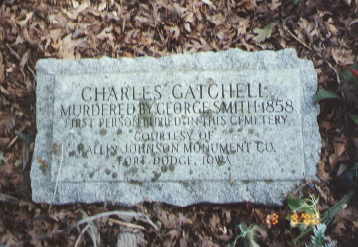Hook's Point - First Settlement - First Murder
By Martin E. Nass
Transcribed for the IAGenWeb Project by Janelle Martin, with permission of Martin "Ed" Nass.
The year was 1850 and the state legislature created two new counties:
Risley and Yell. Presley Bell, who had settled upstream from the mouth
of the Boone River a year earlier, became the first settler. In 1852
Risley and Yell were combined due to the efforts of Granville Burkley.
He was the lawyer who laid out the town of Homer, which became the
county seat of the new Webster County. Another county name change took
place in 1856 when Walter C. Willson was elected to the state
legislature. He had one purpose in mind, and that was to divide Webster
back into two counties. On January 1, 1857, Hamilton County was created
with Webster City as the county seat.

In the early 1850's Isaac David Hook and his brother, James, followed
the Des Moines River north from Des Moines into what was then Risley
County. They settled just north of present day Stratford. As other
settlers arrived, following their route, a settlement grew and took the
name Hook's Point. There is minor dispute about the exact arrival date
of Isaac and his brother. J. W. Lee, the definitive authority on our
history, wrote in his /1912 History of Hamilton County/ that Isaac and
James arrived in 1851. Clara Madsen, author of /Hook's Point Echoes/,
states that they arrived in 1849. She based this on a letter from the
last son of Isaac Hook, Granville Finch Hook. The 1850 United States
Census lists both Isaac and James as residents of Lee County, Iowa.
Whichever date is correct, the fact remains that Isaac and James created
the first settlement in our county. The brothers drove into present day
Hamilton County in a wagon pulled by two horses, Prince and Pat. They
had heard that much of the Bell family was located west of the mouth of
the Boone River, and they wanted to settle near them. The brothers went
to work clearing an area for a log cabin to prepare for the arrival of
Isaac's family the following spring. The walls of the cabin were round
walnut logs, chinked with split sticks and daubed with mud. The cabin
measured 16 X 24 feet. Holes were drilled into the logs in which hickory
sticks were driven to support a bed in one corner of the cabin. This way
only one post was needed to support the bed in a corner of the room. In
April of the next year two wagons arrived carrying Isaac's wife, Sarah
Amanda (usually called Mandy), and their three children; Frank age 15;
Sarah, age 13; and Hannah, age 8. Traveling in the second wagon were
Mandy's parents, John Everhart and his wife, Beulah. Soon after their
arrival, brother James decided to strike out on his own, eventually
settling in Missouri Valley, Iowa.
The trail from the south passed by the east side of the Hook and
Everhart cabins, continued north to cross the Boone River at Fishtrap
Ford, then went up the hill to Homer. From Homer, the trail turned west
to Fort Dodge. Other settlers followed the trail, and a few put up their
own cabins near Hook's.
In 1852, Hook's family gained a daughter, Elizabeth. Also that year,
Isaac bought a steam-powered sawmill, and Isaac, his son Frank, and
Everhart worked to saw up walnut boards to sell to the new arrivals.
Hook added an addition to his own house and put a small store in it. In
1853, the stagecoach arrived following the same trail. It stopped at
Isaac's store before going on to Homer and Fort Dodge. Hook saw the need
for traveler's lodging so he built a hotel to accommodate them. Mandy
cooked the meals for those stopping there. Dan Pointer drifted into
Hook's Point and stayed in the hotel. He told Hook that he could make
bricks using local materials. In 1854 he started a brick operation.
Isaac then built a brick home for his family. Another son, William, was
born that fall. Soon after, the oldest son, Frank, announced that he was
going to marry and move on to South Dakota. The last child of Isaac and
Mandy was Granville Finch Hook, born in 1857.
Isaac decided to plat a town and re-named it Marion City, as it would be
situated in Marion Township. He named his hotel Marion Hotel. A map of
Hamilton County, dated 1857, showed only four towns in the county. They
were Webster City, Hawley, Homer, and Marion City. But the settlers
rejected the name Marion City. They stole Hook's hotel sign and
proclaimed that this was Hook's Point, and the hotel was Hook's Hotel.
The unofficial postoffice was a metal box, measuring 18" X 8" X 10", in
which he kept all of the settlement mail. It was kept under his bed. An
official post office was established on August 21, 1863.
Among the many new settlers were Wes and Sarah Hook, with sons David and
Steve, and Will and Sarah Hook. They built cabins about a mile north of
the settlement. In 1858, when the river was very deep, the Riverland
Company ran the Charlie Rodgers Steamboat upstream passed the Bell
settlement. Most of Hook's Point residents watched from the banks of the
river. The company claimed parcels of land from the government on both
sides of the river. Much of these lands are now under the management of
the Litchfield Land Company.

In this same year, two men, George Smith and Charles Gatchell, operated
a lumber business. They felled trees from the timber area west of Hook's
Point for logs and split fence rails. The rails were left with Isaac
Hook to sell at his store. One Saturday night, the men came to Isaac's
store to purchase supplies and settle up accounts. Half of one batch of
rails were walnut and half were oak. The walnut rails were more
valuable. When Isaac gave the men their money, Smith argued that he had
split most of the walnut logs and deserved more than half of the money.
Gatchell stood his ground and insisted that they had always split the
profit "half and half." The argument became heated, and Gatchell hit
Smith, knocking him off his feet. Isaac, Dan Pointer, and others in the
store separated the men and told them to take their argument outside.
Smith and Gatchell both went to the barroom, which was attended by young
Dave Hook. The men went to opposite ends of the bar. Dan stepped between
them. Things seemed to settle down as the men both drank. When the
argument flared up again, Dan asked the men to leave the bar. Smith
whirled about and headed for the door. As he got to the door, he spotted
a rifle leaning against the wall. It had been left there by another
patron, Olaf Ferlen. Smith grabbed the gun, spun around, leveled the gun
at Gatchell and pulled the trigger. Gatchell cried out, "I'm shot. Why?"
The settlement had no doctor, so there was no one to attend Gatchell. He
lay there in the bar for 25 minutes until he died.
The news traveled to Webster City, and Sheriff Leonard arrived to arrest
Smith. The sheriff took Smith to Judge J. D. Maxwell, who determined
that he would be held for trial. Webster City had no jail so Smith was
put in a room at the Willson House. The McFarland Clinic parking lot is
presently there. After remaining in the hotel a few days, Smith slipped
out through a window and ran away. A posse was formed to ride out and
find him, but it returned empty handed.
Gatchell, the first person murdered in our county, was buried at the
north end of the new Hook's Point Cemetery. The land was donated by
Isaac Hook. Much later, when the cemetery was fenced, it was discovered
that Gatchell had been buried just north of the fence and outside of the
cemetery. He was left outside the cemetery until the 1940's when Fred
Runkle, editor of the _Stanhope Observer_, called people from Webster
and Hamilton Counties to a meeting. They raised funds, bought a strip of
land and moved the fence. From that time until the present, Gatchell
rests inside the Hook's Point Cemetery.
|